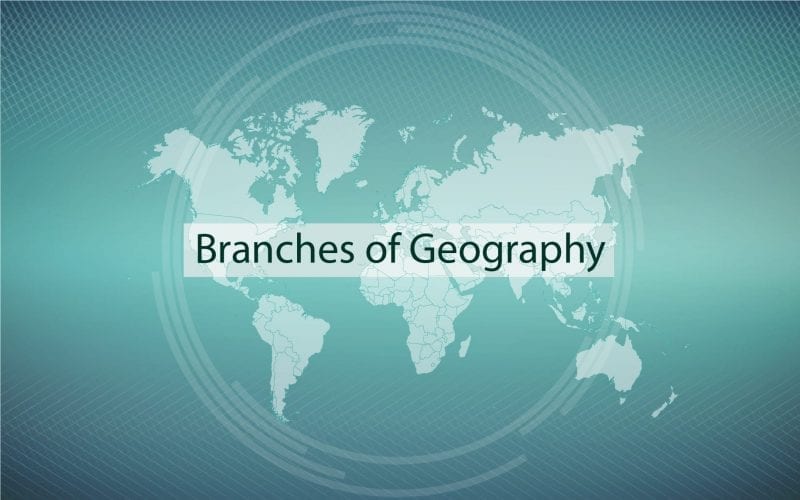Terra Mater (Mother Earth) – Our home is a complex marvel that has various intricacies and phenomena which bring us to life. Many Historians have been fascinated by the details of our surroundings and dug deeper into the various aspects of the earth. The study of geography includes the study of various places, features, and their relationships with each other. All these physical properties and human societies are the basis of geography. Being such an overlapping field, there are numerous branches of human geography and physical geography. Let’s explore the topics that divide this subject into various streams.
Geography Etymology
Greek (geographia)- ‘Geo‘ means ‘the earth’ + “graph” translates as ‘to write’)
This Blog Includes:
Essential Branches of Geography
Being the two essential branches of geography, the following are the various sub-branches that are studied in Human geography and physical geography.

Did you know?
The Continents shift at about the same rate as your fingernails grow,
few centimetres a year!

Human Geography
Also known as anthropogeography, this field explores the social aspects of the earth, how it has evolved through the ages, and the dynamics that change our environment. This branch of geography has various domains, but the 4 important ones are- social, political, economic, and historic aspects.
- The social domain deals the civilizations, cultures, age, sex-ratio, religions, etc. throughout the world. Social geography also deals with demographic details like mortality and fertility rate, migration and census information.
- The political domain concentrates on the government-citizen relation, national issues, environmental effects to the country, foreign relations, etc.
- The economic aspect is concerned with industries, agriculture, trade and labour. Another notable field of economic geography is the burning topic of globalization.
- The historic geography focuses on how the earth has changed over time and how different civilizations have dealt with it.
Examples of Human Geography
- Cultural geography
- Time geography
- Marketig geography
- Historical geography
- Political geography
- Health geography
- Transportational geography
- Social geography
- Regional geography
- Animal geography
Physical Geography
This branch of geography includes the process, natural dynamics and different envelopes of the earth like atmosphere, hydrosphere, biosphere, etc. the domain again has various subfields like:
- Hydrology: It explores the water in rivers, seas, lakes and oceans, glaciers, the hydrological cycle and its impact on the earth’s layers, rocks and landscapes.
- Climatology: One of the most emphasized and studied topics due to its call for the emergency in the world. It includes both-macro and micro climate and their impact.
- Pedology: This domain focuses on soil formation, genesis, its different types, etc. the impact of soil is much more than vegetation or farming. It forms the roots of the earth and has various organisms like – microorganisms, plants, animals – depend on it. It interacts with climate, water, air, temperature.
Did you know?
Russia alone has 11 time zones! So when a Russian on one side of the country is awake at 7 am, folks on the other side might be getting ready to sleep!
Examples of Physical Geography
- Hydrology
- Climatology
- Pedology
- Meteorology
- Oceanology
Integrated Geography
This branch of geography deals with the relation of the earth with humans and vice versa. From the big bang to the current modern era, our planet has evolved and has been greatly impacted by our existence. Humans have consumed the various resources of the earth and also have built machines and equipment to control it. Remote sensors, man-made resources, disasters, etc come under integrated geography.
Also Read: MSc Geography
Cartography
Another interesting branch of geography is Cartography. The practice of making maps and displaying accurate data is called Cartography. It includes scientific, graphic and artistic knowledge on the various regions, states, countries, and continents. As mind-blowing it sounds, a person who wishes to excel in this domain requires a good and creative bend of mind with accurate locations and details. The spatial data of the map can be altered due to the changing environment and dynamics of the earth. It is necessary to keep updating the current global map.
Geomatics
Geomatics is related to Geographic Information Systems and the other geospatial sciences. This branch of geography studies the engineering of collection, distribution, storage, analyze, process, and present data that have been gathered about the geographic information. The development of global positioning systems (GPS), digital aerial imagery (satellite and air-borne), and computer-based geographic information systems (GIS) were possible due to the study in this branch of geography. Geomatics is used in science and engineering to survey and incorporate the other fields.
The discipline of geography is much more vast than just knowing places and locations. It is an extremely important field that affects the environmental health, political aspects and economies of countries which eventually affects us. We hope you’ve understood the various branches of geography through this blog. If you’re someone who wishes to build a career in this field, our experts at Leverage Edu will assist you through your journey!

 One app for all your study abroad needs
One app for all your study abroad needs






















 45,000+ students trusted us with their dreams. Take the first step today!
45,000+ students trusted us with their dreams. Take the first step today!


